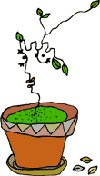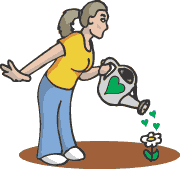
So many Choices!
What to look for when choosing a plant
By Marion Owen, Fearless Weeder
for PlanTea, Inc. and
Co-author of Chicken Soup for the Gardener's Soul
FEATURE ARTICLE:

Tom Hanks' "Power of Four" solution
More good stuff:
Who is Marion Owen?
FAQs about PlanTea
Search Marion's articles, tips and recipes
Why grow organic?
News and press releases
Read love letters
How to link to this site
Need a speaker?
How to contact Marion
Visiting Alaska?
Come to Kodiak Island!
Go to home page

Marion's UpBeet Gardener
Newsletter has been
replaced by Marion's blog
which you can find at:
www.marionowen.wordpress.com
Garden centers offer a staggering variety of plants. It's a match made in gardener's heaven: They have plants, and you want plants. I'm the first to admit however, that when I enter a nursery I throw caution to the wind. Faced with so many choices, my shopping list stretches like warm taffy and I usually end up with more plants than I intended.
Buying annuals and perennials direct from a garden center allows you get the pick of the litter, so long as you know what to look for. Here are some valuable tips you'll want to carry with you when plant shopping:

Bushy is better
Select plants that are bushy and full. Avoid plants that are spindly and sparse, as they may be root-bound, light-starved, or have been subjected to extreme heat, dehydration, or lack of vital nitrogen.
Get to the root of the matter
See if there are roots growing out the pot's drainage holes. If none are showing, gently--and I mean GENTLY, since you haven't bought the plant yet--remove the plant and root ball from the pot and see if the roots are growing in a circular pattern. Both of these signs means the plant has been in the pot way too long. It ma,y or may not, survive being transplanted.
You CAN judge a plant by its color
The rule of thumb is to pick a plant with healthy, lush leaves. With the exception of naturally variegated leaves, leaf color can tell you a lot about plants. Here are some color tips to help you tell the difference between a healthy and sickly plant:
YELLOW (yellow) or LIGHT GREENYellow or light green leaves usually indicates that the plant lacks one or both of the following:
1) Nitrogen (N) --The plant turns light green, followed by a yellowing. Also called chlorosis, nitrogen deficiency stunts growth and causes leaves to fall off, beginning with the older ones.
2) Sufficient light

SILVER
or PURPLE
A silver or purple cast to the leaves mean the plant has had poor care in
general, or that it was cold-damaged. Leaves turn silvery or purple when
subjected to cold air. You see this happening when seedlings, such as marigolds,
are transplanted outside while the air temperature is still too cool. Plants
usually recover and put out new growth if growing conditions improve.
DARK GREEN
or BLUE-GREEN
It's hard to imagine, but there are times when greener is not always better.
A lack of phosphorus (P) causes leaves to take on an almost surreal dark
green or dull, blue-green color. Dark, extra-dark leaves may also indicate
the plant has received too much nitrogen-based chemical fertilizer.
+ + Tongue-in-Cheek Definitions + + |
Those pesky pests
Check plants for pests by inspecting stems, leaves and the surface of the soil. Don't forget to look UNDER the leaves for hitchhikers. To an observer, you might look like an finicky shopper, but there's nothing worse than introducing an army of pests through a 'Trojan Horse' plant.
Inspect the flowers
If you know the plant you're buying has the right flower color you're looking for, then choose one that's not in bloom but has plenty of buds. (Reason: A plant with buds, but not yet blooming can direct energy toward establishing a healthy root system. As a result, the bloom period will be longer and more prolific). On the other hand, if you don't know the flower color, find a specimen with a bloom so there won't be any surprises.
Get the right plant
It may sound silly, but labels do get switched or lost. If there's any doubt, ask a staff member to verify the plant. Speaking of plant labels, I read an account of a Delaware woman whose formal garden was featured on the local garden tour. A young mother finished the tour, thanked her host and handed her the 50 plant labels her children had collected.
Meanwhile, back at the garden
Before heading out on a plant shopping spree, have a spot prepared (and not just in your mind!) It's a shame to bring home lots of beautiful plants in pots or flats only to have them shrivel, become stressed, or even die sitting around waiting for a bigger, better home in the soil. If you can't get them into the ground immediately, provide a holding area for them out of direct sun, heavy rain, or gusty wind. Keep them well watered and don't let them dry out.

Transplanting tips
Transplant bedding plants on an overcast, foggy or drizzly day to prevent
transplant shock. Water your plants well, loosen the roots by massaging
the pot or  wiggling the plant. Dig a hole slightly larger than the root
ball, making sure the soil is also damp. It is very important that the
plant's roots make immediate wet-to-wet contact with the new soil. Set
the plant in and press the soil around it firmly, but gently. Keep a close
eye on them for the next couple weeks. Have shade and frost covers handy,
and protect them from birds, cats, and dogs that like to dig in the garden!
wiggling the plant. Dig a hole slightly larger than the root
ball, making sure the soil is also damp. It is very important that the
plant's roots make immediate wet-to-wet contact with the new soil. Set
the plant in and press the soil around it firmly, but gently. Keep a close
eye on them for the next couple weeks. Have shade and frost covers handy,
and protect them from birds, cats, and dogs that like to dig in the garden!
Next time you go plant shopping, make a list and remember to think "bushy"!
Thanks for visiting and please stop by again. I'll put the coffee on!
Meet Marion Owen /// Learn about PlanTea /// Online Catalog /// Articles, Tips, Recipes /// Get free UpBeet Gardener newsletter /// Read current issue /// Listen to radio show /// Read news and press releases /// More resources and links /// Learn why 'grow organic?' /// View guidelines for retailers /// Read love letters /// Book Marion as a speaker /// Site map /// How to link to us /// Contact us /// Go to home page
PlanTea: The organic plant food in tea bags. http://www.plantea.com
Copyright ©1996 to present: PlanTea, Inc. All Rights Reserved. PO Box 1980, Kodiak, AK 99615-1980 USA
Questions or comments? marion@plantea.com Phone: Toll Free: 1-800-253-6331 (US and Canada); 907-486-2500